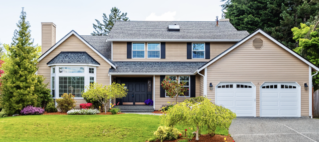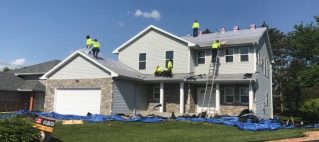How to Get Insurance to Pay for Roof Replacement After a Storm
You’ve sustained roof damage after a storm. It’s no fun, but you’re not alone. Here in the Minnesota and Wisconsin area, we have beautiful vistas and powerful weather. When a storm takes out your roof, there are people you can trust to turn to for advice and assistance. At Built Strong Exteriors, we’ve helped hundreds of homeowners get through roof repair and replacement after a storm. We’re here to help you, too.
In addition to getting a temporary repair in place to prevent further damage, finding a reputable contractor to do the repairs, and budgeting for the costs, you’re also dealing with your homeowner’s insurance agents and inspectors. They have a job to do and laws, regulations, and procedures to follow.
Understanding and meeting the requirements to prove your roof damage was from the storm can be daunting and difficult. Here are some tips to help you figure out how to get your insurance to pay for your roof replacement after a storm.
Understand the Challenge
Homeowner’s insurance policies are designed to protect the structure of your home from perils, such as wind and hail damage, or fire. If a storm damaged your roof, then your insurance policy will usually help cover the cost of roof repairs or replacement. Some ways your roof may sustain storm damage are from hail, wind ripping off shingles, vents, or chimneys, or a tree falling on your house. Your insurance policy will only cover your roof repairs if they are demonstrated to be caused by a storm or other peril. Insurance does not cover roofs that need repair or replacement due to normal wear and tear or the age of the roof.
Insurance companies heavily scrutinize claims for roof repair and replacement. They will want absolute proof that storm damage is the cause for the roof leak and subsequent repairs. If they determine that the roof leak was the result — even partially — of a lack of maintenance, then your insurance may reduce the amount it will pay or not cover the claim at all. Roof leaks caused by improper gutter cleaning or installation, the seal around a vent failing, worn-out shingles, deteriorated ridge vents or fascia board, the age of the roof, or other maintenance problems will not be eligible for insurance payment. You must prove that the storm damaged your roof and not any other cause.
Know What Your Insurance Policy Says
Before you discuss the claim with an adjuster, be sure to read over your homeowner’s insurance policy, especially as it pertains to roof replacement. Some policies contain windstorm and hail exclusions, which means they do not cover damage from storms or hail. This is not common but is becoming more common, so check for this exclusion right away.
Next, look for your insurance policy’s deductible and coverage limits. The deductible is the amount you must pay out of pocket toward a covered claim. The insurance company deducts this amount from the payment it provides. Typical deductibles are $500, $1,000, and $1,500, but policies are now being written that set the deductible as a percentage of the home’s value. Whatever your deductible, you must pay that amount first, before the insurance coverage kicks in. Make sure you’re aware of the amount you will have to pay out of pocket, even after the insurance covers the claim.
Coverage limits are the maximum amount your insurance company will pay for any loss. If you sustain $15,000 in damage, but your insurance coverage limit is $10,000, then the remaining amount above the limit will be yours to pay. Your insurance agent can adjust your deductible and coverage limits as needed. Generally the lower the deductible and the higher your coverage limits, the more you will pay in insurance premiums. You won’t be able to adjust these amounts while you have a claim in progress. When a disaster happens, you may only use the insurance coverage you had in place at the time.
Depreciation and Insurance Payouts
Check your policy for its rules about depreciation. The age of your roof often determines the amount you will be reimbursed for roof repairs. Generally, if your roof is less than 10 years old, your policy will cover the costs to repair or replace the sections that were damaged by the storm at the actual value.
However, if your roof is 10 or more years old, most policies consider the roof’s age and lower the reimbursement amount you’ll receive based on how old the roof is. The insurance companies essentially value your home’s roof less if it is older and on its way to needing replacement anyway. They will pay you the costs to return the roof to its aged and worn condition before the storm damage, rather than pay the costs to replace the roof with a new one. Depending on where you live, the depreciated value may be the norm for roof replacement coverage, no matter what the age of your roof is.
If your insurance company uses a depreciated value to estimate the damage, you very likely will not receive enough funds from the claim to fully cover the costs of a roof replacement. But then, you’re getting a new roof, whereas, before the damage, your roof was not new.
Document, Document, Document
When a storm damages your roof, you need good evidence to prove the cause. Be sure to take lots of pictures of the roof, and whatever debris was left from the storm. Get a good shot of the tree limb, any dents or broken vents, the collapsed gutter, or the area where the shingles were blown off, as well as where they ended up if you can find them.
Get your paperwork in order for any roof repairs or roof maintenance you have had done while you were the homeowner. You want to prove that your roof was in good repair before the storm happened.
Get a roofing specialist on site who can inspect the damage and make a determination about the cause. This person can write up a report and submit it to the insurance company. If the insurance adjuster agrees that the storm caused the damage, the roofer’s report helps prove that determination. If the inspector states that the damage was caused by lack of maintenance or the age of the roof, the roofer’s report will help refute that. Either way, it’s an essential piece of evidence you need as you go through the insurance claims process.
We’re Here to Help
At Built Strong Exteriors, we’ve been through the storm, insurance claim, roof repair cycle countless times. We can help reassure you through the process. We’ll help you get a temporary repair on your roof to stop further damage, and we’ll inspect and analyze your damage to write the report for your insurance. We’ll talk with your insurance adjuster if needed, and help you navigate this process. And, of course, we’ll be there to repair or replace your roof once your claim is settled.




